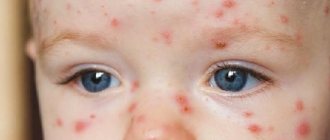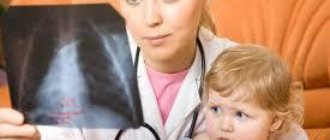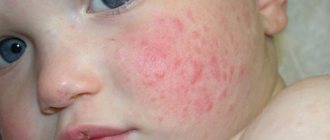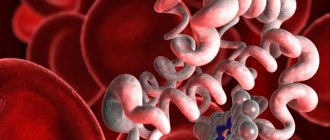Editor
Anna Sandalova
Pulmonologist, doctor of the highest category
Tuberculosis in children of primary school age and adolescents often has a vague clinical picture, which does not always correspond to the severity of the disease. Society still maintains a stereotypical idea that pulmonary tuberculosis is a disease with a constant hacking cough and profuse hemoptysis.
Unfortunately, for this reason, nonspecific symptoms of intoxication in a child are often regarded by parents as overwork due to school or everyday activities. Meanwhile, the disease continues to progress and leads to severe complications.
We urge you not to self-medicate and consult a doctor in a timely manner! Please do not use the described treatment regimens without consulting a doctor - it is dangerous to your health!
Statistics
In schoolchildren and children of the older age group, pulmonary forms of the disease predominate (92%). In this case, the following pattern is observed: the younger the child, the more common primary pulmonary tuberculosis is . In adolescents aged 14-17 years, secondary forms are diagnosed in 80% of cases.
Extrapulmonary tuberculosis occurs in 15% of schoolchildren and adolescents and is mainly represented by damage to peripheral lymph nodes (PLN). Damage to the genitourinary and osteoarticular systems is less common. In 1% of cases, tuberculous meningitis occurs, but only in children with a weakened immune system in combination with massive infection with mycobacteria.
Tuberculosis in children and adolescents in Russia
The incidence of tuberculosis in children is considered an important prognostic epidemiological indicator, reflecting the general epidemic situation of tuberculosis in the region. This is due to the fact that tuberculosis in children most often occurs immediately after contact with a source of infection [1].
An analysis of epidemiological indicators for tuberculosis (sources: state forms of the Russian Federation No. 8 and No. 33, population - forms No. 1 and No. 4) in the period from 1992 to 2001. in the Russian Federation as a whole, the registered incidence of tuberculosis in children aged 0–14 years has more than doubled (from 9.4 to 19.1 per 100 thousand children). Over the next five years, the incidence rate practically ceased to change, with only slight fluctuations ranging from 16.2–16.4 per 100 thousand within the 95% confidence interval. In 2008, the incidence of tuberculosis in Russia decreased to 15.3 per 100 thousand population, and then stabilized again at the level of 14.7–15.3 per 100 thousand children. Over the past two years, there has been a steady increase in the rate of registered incidence of tuberculosis in children from 14.6 in 2009 to 16.3 per 100 thousand children in 2011 (3545 newly diagnosed children aged 0–14 years). The share of children under 14 years of age in the structure of the morbidity rate of the entire population (form No. 8 of state statistics of the Russian Federation) decreased from 3.8% (1999) to 2.7% in 2009 and to 3.2% in 2011. The incidence of children aged 15–17 years is recorded more reliably than children under 14 years of age, since in the former, severe forms of tuberculosis predominate, accompanied by significant radiological changes and bacterial excretion. A significant proportion of adolescents undergo preventive examinations in connection with training in an organized group and the need to determine suitability for military service. In adolescents, in contrast to children aged 0–14 years, an increase in incidence was observed until 2005. In the period 2002–2005. the incidence rate among adolescents increased from 32.7 to 40.5 per 100 thousand population, changing slightly within the 95% confidence intervals, and in 2011 the incidence rate of adolescent tuberculosis was 30.9 per 100 thousand population. When analyzing the incidence of tuberculosis in children by federal districts, it was noted that in the east of the country, in the Siberian and Far Eastern federal districts, the value of this indicator is almost twice as high as in the Urals, in the central, southern and western regions of the Russian Federation. This information once again confirms the fact that the epidemiological situation regarding tuberculosis in the east of Russia is significantly more alarming than in its other regions [2].
Significant differences in the values of the indicator in the constituent entities of the Russian Federation often cannot be explained by the course of the epidemic process and are not related to the socio-economic and climatic-geographical characteristics of the regions, but are determined by the organizational and methodological characteristics of the system of preventive, therapeutic and diagnostic measures carried out among the child and adolescent population, which confirmed by studying the structure of newly diagnosed tuberculosis.
Clinical forms of the disease in children are characterized by the predominance of respiratory tuberculosis in the form of damage to the intrathoracic lymph nodes without spreading to the lung tissue. In children under 7 years of age, respiratory tuberculosis occurs with damage to the lung tissue only in 9.2% of cases, in children 7–14 years old - in 29.1%, and in adolescents - in 86.5%. The proportion of bacterial excretors in children aged 0–14 years is only 5% (174 people). However, given the predominant involvement of intrathoracic lymph nodes in children, bacterial excretion cannot be the main criterion for the prevalence of the process. Despite the fact that the number of children and adolescents with bacterial excretion is small (173 children and 358 adolescents were registered in regional dispensaries at the end of 2011), the proportion of patients excreting multidrug-resistant (MDR) tuberculosis bacteria among them is high - 22 .5% and 20.4% respectively. In children under 14 years of age, tuberculosis of the intrathoracic lymph nodes predominates (64–90%), the course of the process often corresponds to MDR tuberculosis, bacterial excretion is not typical. This fact indicates the emergence of a new problem in tuberculosis in children, requiring a revision of approaches to the treatment of children, even with minor forms of the disease with damage to the intrathoracic lymph nodes. The proportion of extrapulmonary tuberculosis against this background, paradoxically, has shown a decreasing trend over the past fifteen years; patients are identified mainly “by referral,” which confirms the insufficiency of health authorities in diagnosing this disease. Thus, the number of children with urological tuberculosis is decreasing from year to year - from 133 patients in 1997 to 36 people. in 2011. Undiagnosed in childhood, genitourinary tuberculosis almost never ends spontaneously and is characterized by a tendency to progress with the formation of destructive processes in adulthood, often leading to loss of organ function and the need for organ removal operations. This can explain the sharp increase in the Russian Federation in the number of patients with destructive forms of kidney tuberculosis and genital tuberculosis aged 18–35 years. In 2011, out of 1138 newly diagnosed tuberculosis patients of all ages, genitourinary tuberculosis was diagnosed in 419 people.
The same trend towards a decrease in the detection of the disease is observed in children with lesions of peripheral lymph nodes - from 168 patients in 1997 to 68 people. in 2011, which indicates a decrease in the number of preventive examinations of children at risk for the disease of this localization.
Against this background, the number of children with osteoarticular tuberculosis continues to increase - 127 children in 2011 versus 98 people. in 1997. In general, in 2011, among children under 14 years of age with extrapulmonary tuberculosis, osteoarticular tuberculosis predominated (40.2%). This form of tuberculosis in 80% of cases was noted before the age of one year, which can be explained by the BCG etiology (BCG - Bacillus Calmette-Guerin (BCG; Mycobacterium bovis BCG) of the process (post-vaccination BCG osteitis, not bacteriologically confirmed and not BCG-identified Mycobacterium tuberculosis (MBT) strains).
The absence of an increase in severe generalized forms of tuberculosis and tuberculous meningitis in children, a recognized indicator of the effectiveness of vaccination, shows the high quality of preventive measures in this age group. According to statistical indicators, after a decrease in cases of tuberculous meningitis in 2005–2006, the frequency of this pathology has remained approximately at the same level for the last four years (in 1997 - 38 cases, in 2005 - 27 cases, in 2006-2006). 2010 - 20–23 cases).
Mortality from tuberculosis in children is extremely low: in recent years it has been about 0.08 per 100 thousand children (13 cases in the Russian Federation in 2011).
Thus, the structure and localization of tuberculosis in children differ significantly in different age groups, while the structure of newly diagnosed tuberculosis reflects the work of health authorities in the regions on the prevention and early detection of the disease. All of the above justifies the need to search for new approaches in the work of TB specialists in this direction.
In the Russian Federation, for many decades, a lot of systematic work has been carried out to prevent tuberculosis in children. A whole system of anti-tuberculosis measures has been developed and applied. Providing anti-tuberculosis care to children and adolescents is mainly preventive - preventing tuberculosis infection, timely detection of newly infected people, dispensary observation of children and adolescents with an increased risk of tuberculosis and patients with tuberculosis in order to prevent the development of the disease. Studying the influence of risk factors on the overall incidence of tuberculosis in children allowed us to identify certain patterns that are of particular concern.
In general, in anti-tuberculosis institutions at the end of 2011, 630,496 children and adolescents from all risk groups for tuberculosis were observed (IV and VI groups of dispensary registration (GDU)), or 24 children under 17 years old among every thousand children of this age (2, 4% of the population of this age). Despite the large material costs of the state to work with this group of the population, 1315 children and adolescents fell ill with tuberculosis, which amounted to 211.5 people. per 100 thousand average annual number of contingents of the considered GDUs. In recent years, Russia has maintained a high incidence of children from tuberculosis foci, which reached 546.2 cases by 2011 (1/10 of all sick children). The incidence rate of children from contacts with bacteria-releasing agents in 2011 exceeded the incidence rate in these age groups in the Russian Federation as a whole by 30 times, and in adolescents by 25 times. The high incidence of children and adolescents from tuberculosis foci should alarm TB specialists and require a revision of approaches to the methods of carrying out preventive measures in this group of people.
Primary infection of children with Mycobacterium tuberculosis is reflected in the number of VIA GDU. The annual detection rate of such children is just over 1% of the population aged 0–17 years (1.2% in 2011). An important reason for the development of tuberculosis in this group of dispensary records is ineffective chemoprophylaxis. As a rule, chemoprophylaxis is carried out with one anti-tuberculosis drug on an outpatient basis and in a short time, which turns out to be insufficient to prevent the development of the tuberculosis process - only the delimitation of specific inflammation occurs with the formation of small calcifications.
The peculiarity of the child’s body is the possibility of spontaneous recovery from tuberculosis by delimiting the source of inflammation with the subsequent formation of petrification or fibrosis of the surrounding tissue at the site of the lesion. This outcome of tuberculosis is most often observed with damage to the lymph nodes, liver and spleen. Children with residual post-tuberculosis changes are identified during X-ray examination for positive sensitivity to tuberculin by 2 TU (tuberculin units) or other pathology. For this reason, the quality of diagnostic work among the child and adolescent population in the Russian Federation can be judged on the basis of information on the proportion of children aged 0–17 years registered in IIIA GDU in relation to all newly identified children and adolescents. In the country as a whole, about 1 thousand children under 14 years of age with residual post-tuberculosis changes are registered annually. In 2011 alone, 1,355 children with tuberculosis in the phase of reverse development were identified, while the share of those registered in IIIA GDU in relation to newly diagnosed children has varied within the last two years within 23–25%. Note that if the tuberculosis process is detected in a timely manner, then the official statistical indicators of the incidence of tuberculosis in children in the Russian Federation will increase by almost a third. Self-healing from tuberculosis with the formation of calcifications and scar changes in the lesion is often incomplete. Children retain signs of tuberculosis intoxication, which may be one of the reasons for the development of secondary tuberculosis in adolescence and in young people. In the future, such patients may experience reactivation of the process (especially in adolescence and young adulthood), requiring surgical treatment by removing large residual post-tuberculosis changes.
HIV infection is an acute problem in the country. Unfortunately, in modern conditions we cannot protect a child both from HIV infection and from subsequent tuberculosis. If 10 years ago this combined pathology was found in isolated cases, now it is diagnosed much more often: in 2011 alone, 101 children were identified.
From the above it follows that tuberculosis in children and especially adolescents is a serious problem in the Russian Federation. The continuing high incidence rates in risk groups for tuberculosis require a revision of the existing principles of preventive measures and a serious correction of the entire system of anti-tuberculosis care for children and adolescents.
The main method of specific prevention of tuberculosis is immunization with BCG and BCG-M vaccines.
According to Rospotrebnadzor, BCG immunization coverage of newborn children in the Russian Federation in 2010 was 93%, a total of 1,625,791 children aged 1 year were vaccinated. The lowest BCG vaccination coverage was observed in Moscow (77%), St. Petersburg (80%) and the Republic of Ingushetia (82%). The first revaccination covered only 18% of children aged 7 years, and the second revaccination covered 8%. The presented data show that the immunization of children with the BCG vaccine in the Russian Federation as a whole is carried out satisfactorily. Sufficient vaccination coverage of newborns helps protect children from severe generalized forms of the disease and infant mortality from tuberculosis. The extremely low coverage of BCG revaccinations is justified by the high level of MTB infection and the need to intensify efforts to identify the most endangered group of the population and carry out high-quality preventive measures in this group to protect against the development of local tuberculosis. One of the problems with immunization with the BCG vaccine is the risk of post-vaccination complications. The BCG and BCG-M vaccines, like any live vaccine, can cause tuberculosis both at the site of vaccine administration and in the form of generalized forms of the disease. Children with a complicated course of BCG vaccination are treated with anti-tuberculosis drugs and should be observed by a phthisiatrician. Children with post-vaccination complications have been observed in the V GDU since 2005. In 2011, 607 children with a complicated course of BCG vaccination were registered for the first time, of which 589 were aged 0–14 years, and 15 were aged 15–17 years. Severe complications of BCG vaccination (generalized and disseminated BCG infection requiring hospital treatment) occurred in 159 children and are usually associated with disorders in the child’s immune system.
Thus, the problem of complications during tuberculosis vaccination remains relevant to this day and requires further study, but this is not a reason to revise the policy in the field of primary BCG vaccination.
In recent decades, tuberculin diagnostics has been the main method of mass screening of children and adolescents for tuberculosis to identify specific sensitization of the body. In general, in the Russian Federation in 2011, about 91.2% of children aged 0–14 years were examined using the tuberculin diagnostic method. On average in Russia, the effectiveness of tuberculin diagnostics as a method of detecting tuberculosis in children aged 0–14 years was 0.1 identified tuberculosis patients per 1 thousand examined children. Despite the fairly good coverage of the child population, tuberculin diagnostics detects slightly less than half (48.1%) of children under 17 years of age. Every year, up to half a million children in the country are registered in anti-tuberculosis dispensaries (PTD) for group VI and receive preventive treatment. However, despite the government resources spent, the incidence rate in this cohort exceeds the general incidence of children by 5 times (in 2011, the incidence of children in group VI of PTD accounting was 240 per 100 thousand of the corresponding group). Such a low efficiency of the tuberculin diagnostic method requires the development of indications for its differentiated use during preventive examinations or the search for new ways to identify children with tuberculosis.
In Russia, the most promising method for conducting screening examinations of the population for tuberculosis is an innovative diagnostic method - an intradermal test with the drug Diaskintest®, which is easy to perform and does not require additional costs for expensive laboratory equipment. Scientific and clinical studies have shown that the Diaskintest method allows one to objectively and with high accuracy identify individuals at high risk of tuberculosis. This fact is confirmed by official statistical indicators of the Russian Federation. Following the implementation of Order No. 855 of the Ministry of Health of the Russian Federation “Recommendations on the use of recombinant tuberculosis allergen in standard dilution” in 2010 in 37 regions of the Russian Federation, and in 2011 in all regions of the country, Diaskintest began to be used in the diagnosis of tuberculosis in the conditions of anti-tuberculosis service. According to official government statistics, the first preliminary results have been received. Thus, by 2012, against the background of a slight increase in the incidence of tuberculosis in children in the country, there was an increase in the proportion of minor forms of tuberculosis and the number of children identified with residual post-tuberculosis changes. The incidence of children from IIIA GDU has always been very high. According to reporting form No. 33 for 2008, the incidence of tuberculosis in children aged 0–17 years from this GDU exceeded 1.5%, which amounted to 1573 people. per 100 thousand average annual size III GDU. In 2011, the incidence rate of children from this group of dispensary observation for the age of 0–17 years decreased to almost zero; only three cases of tuberculosis were identified. The results obtained provide the basis for the need for further implementation of Diaskintest in the Russian Federation as a screening method for examining tuberculosis, which will reduce unnecessary costs for additional examination of the population, significantly improve the quality of diagnosis of tuberculosis infection and improve the situation with tuberculosis incidence in general [3–6].
Conclusion
An analysis of the epidemic situation in the country showed that tuberculosis in children and especially adolescents is a serious problem. Tuberculosis in children in the 21st century differs from similar problems in previous years and requires a revision of generally accepted measures both in the general pediatric service and among TB specialists. Considering the existing priorities in working with the child population, a differentiated approach in the work of phthisiopediatric and general medical services in matters of prevention and early detection of the disease is important.
Today, the health of the nation associated with tuberculosis is being laid for several generations to come. Therefore, preventing tuberculosis infection in children and adolescents is one of the most important tasks of healthcare and the state. In this regard, it is necessary to develop appropriate projects aimed at preventing tuberculosis infection and improving dispensary observation of children and adolescents.
The priority should be vaccine prevention in uninfected MTB at an early age and timely early detection of the tuberculosis process using the innovative diagnostic method Diaskintest, as well as comprehensive preventive treatment of children with confirmation of active tuberculosis infection.
To improve preventive measures, an important task of specialists in childhood tuberculosis is to protect the child from patients with contagious forms of tuberculosis, therefore it is necessary to change the system of isolating the patient for the period of treatment and improve the system of preventive treatment of children at risk in the conditions of sanatorium and health institutions.
Literature
- Aksenova V. A. Infection and incidence of tuberculosis in children as an indicator of the general epidemiological situation regarding tuberculosis in Russia // Problems of tuberculosis. 2002. No. 1. P. 6–9.
- Tuberculosis in the Russian Federation. Analytical review of statistical indicators on tuberculosis used in the Russian Federation. 2011. P. 223.
- Arend SA, Franken WP, Aggerbeck H. et al. Double-blind randomized Plhase I study comparing rdESAT-6 to tuberculin as skin test reagent in the diagnosis of tuberculosis infection // Tuberculosis. 2008. V. 88. P. 249–261.
- Brosch, R., Gordon SV, Billault A., Gamier T., Eiglmeier K., Soravito C., Barrel BG, Cole ST Use of Mycobacterium tuberculosis H37 Rv bacterial artificial chromosome library for genome mapping, sequencing, and comparative genomics // Infect. Immun. 1998. V. 66. R. 2221–2229.
- Harboe M., Oettinger T., Wiker HG, Rosenkrands I., Andersen P. Evidence for the occurrence of the ESAT-6 protein in Mycobacterium tuberculosis and virulent Mycobacterium bovis and for its absence in Mycobacteriuin bovis BCG // Infect. Immun. 1996. V. 64. R. 16–22.
- Dfel P., Nienhaus A., Loddenkemper R. Cost effectiveness of interferon-gamma release assay screening for latent tuberculosis infection treatment in Germany // Chest. 2007. V. 131. P. 1424–1434.
V. A. Aksenova, Doctor of Medical Sciences, Professor T. A. Sevastyanova, Candidate of Medical Sciences
Research Institute of Phthisiopulmonology, State Educational Institution of Higher Professional Education, First Moscow State Medical University named after. I. M. Sechenova, Moscow
Contact information for authors for correspondence
Pulmonary tuberculosis
At 7-13 years old
In children under 14 years of age, the morbidity structure is dominated by primary pulmonary tuberculosis . There are three types of primary tuberculosis, which have a largely similar clinical picture:
- Tuberculosis intoxication. In this case, there are no specific changes in the lungs and intrathoracic lymph nodes. Symptoms of endogenous intoxication and asthenic syndrome come to the fore in the clinical picture: weight loss, weakness, apathy, unmotivated fatigue, drowsiness or insomnia, temperature up to 38°C. In children with sufficient immune reactivity, intoxication syndrome is pronounced and is combined with enlarged lymph nodes.
- Primary tuberculosis complex (PTC). The clinical picture of this form is scanty, but with massive infection with mycobacteria, the symptoms become pronounced. The main signs of PTC are two syndromes: intoxication and bronchopulmonary-pleural. Intoxication syndrome is manifested by intermittent fever and functional disorders of the nervous system (irritability, frequent mood swings, fatigue during mental stress, decreased concentration and attention span). Bronchopulmonary-pleural syndrome is characterized by the appearance of a persistent dry cough, less often with scanty sputum. Sometimes there is shortness of breath and pain in the chest on the side of the tuberculous lesion (only when the pleura is involved in the process).
- Tuberculosis of the intrathoracic lymph nodes (TIHLN). This form is considered the most common type of disease in children of all age groups. It is characterized by isolated damage to the bronchopulmonary lymph nodes without involvement of the lung tissue in the infectious process. If no more than two lymph nodes are affected, there are no symptoms at all. When 3 or more lymph nodes are involved in the pathological process, symptoms of intoxication gradually increase. In rare cases, a dry whooping cough appears. If enlarged nodes compress the trachea or main bronchi, the child experiences noisy wheezing and shortness of breath.
The severe course of pulmonary tuberculosis is indicated by the severity of the intoxication syndrome. The more massive the infection with mycobacteria, the more the child’s general well-being suffers.
Difference between primary and secondary tuberculosis.
At 14-17 years old
A distinctive feature of the disease in adolescents is an increase in the incidence of secondary forms and a decrease in the incidence of primary forms. Symptoms of primary pulmonary tuberculosis in adolescents resemble the clinical picture of those in younger children. The only difference is that the intoxication syndrome is less pronounced.
In most cases, the secondary form of pulmonary tuberculosis in adolescents is represented by two types: focal or infiltrative . The share of other forms (caseous pneumonia, miliary tuberculosis and other types of hematogenous dissemination) accounts for up to 10%.
In children of the older age group (15-16 years and older), the symptoms of lung damage largely acquire similar features to the clinical picture in adults. At this age, damage to the lung tissue in the form of infiltrative forms with massive release of mycobacteria into the environment is especially characteristic. At the same time, children have a high tendency to decay of lung tissue and the formation of foci of necrosis, which quickly increase in size without adequate pharmacotherapy.
In adolescents, there is often a discrepancy between the severity of tuberculosis and its clinical manifestations: the general condition may remain satisfactory for a long time.
Focal tuberculosis usually develops 2-4 years after the initial infection. It is characterized by the occurrence of local caseous bronchopneumonia (Abrikosov lesion). In the future, the infection may spread through the lymphatic vessels with the formation of additional foci. The inflammatory reaction increases around the lesions, then a dense fibrous capsule is formed, and the disease becomes chronic with an undulating course. In the early stages, there are usually no specific signs. As the disease progresses, the following symptoms appear:
- increased sweating (mainly at night);
- low-grade fever in the afternoon;
- weakness, lethargy, apathy;
- poor appetite and weight loss;
- insomnia or interrupted sleep;
- weak cough with a scant amount of sputum (hemoptysis occurs in 2% of cases).
Infiltrative tuberculosis most often results from the progression of the focal form and is characterized by widespread damage to the lung tissue. With a small affected area, the symptoms are similar to those of focal tuberculosis. In case of damage to several segments, the disease begins subacutely and has clear first symptoms:
- severe intoxication of the body - temperature can reach 38 degrees or more, severe weakness and complete intolerance to physical or mental stress;
- cough with sputum or coughing up blood;
- pain in the chest when breathing (a sign of pleural damage).
In adolescents with pulmonary tuberculosis, the clinical picture is dominated by nonspecific symptoms: a slight rise in body temperature, increased sweating, fatigue and poor appetite.
What you need to know about childhood tuberculosis
Author:
Reznik Irina
7 minutes
5275
Where children encounter tuberculosis, who is at risk, how the Mantoux test differs from Diaskintest, and why refusal of vaccination and screening is so dangerous, said the chief pediatric phthisiatrist of the Ministry of Health of the Russian Federation, Head. Laboratory of Tuberculosis in Children and Adolescents of the Federal State Budgetary Institution "National Medical Research Center for Phthisiopulmonology and Infectious Diseases" Valentina Aksenova.
Why do children get tuberculosis and where do they encounter the infection?
You can become infected with tuberculosis anywhere - in transport, in supermarkets, in any closed spaces with large crowds of people. Even short-term contact with a sick person is dangerous for a child, and the infection is simply in the air. But this does not mean that a healthy child with a normal immune system who catches the infection will definitely get sick - in 9 out of 10 cases, immunity is triggered. An infected child can live safely without tuberculosis throughout his life. However, under certain conditions that reduce the body’s resistance, Koch’s bacillus from the so-called “dormant mycobacterium” becomes active, virulent, and already causes disease. This is how secondary tuberculosis develops.
Primary tuberculosis often affects children who find themselves in a hotbed of infection when mycobacteria are actively released by someone from their close circle - relatives, teachers. It is especially dangerous if it is a drug-resistant bacteria, because the child is immediately infected with the drug-resistant bacterium. Therefore, all measures should be taken to ensure that the child becomes less infected, and if he becomes infected, he does not get sick.
Who's at risk
If social and behavioral factors play a significant role in the development of tuberculosis in adults, then medical factors are more relevant for children. Thus, according to WHO, patients with diabetes mellitus develop tuberculosis 4-5 times more often. The likelihood of getting sick increases in children with chronic diseases of the lungs, gastrointestinal tract, as well as in patients who receive hormonal therapy or drugs that suppress the immune system. Thus, in the Clinical Guidelines for the Treatment of Rheumatoid Arthritis in Children, there is a section regarding the prevention of tuberculosis in children receiving immunosuppressive therapy (for example, genetically engineered drugs). Immunodiagnosis of such children should be carried out at least twice a year. The high-risk group includes children with HIV infection who do not have immune protection - the likelihood of developing tuberculosis with HIV infection increases 30-40 times.
What forms of tuberculosis occur in children
Latent form
In most cases, this is a latent form; the active form at this age occurs in 5-6% of cases. The latent form of tuberculosis can hide the signs of the disease for a long time. Despite the fact that a child with this form of the disease practically does not feel it and is not contagious to others, the infection slowly destroys his body, and the disease enters the chronic stage.
Active form
The specificity of childhood tuberculosis is that in most cases children are not bacteria excretors, since the intrathoracic lymph nodes located inside the body are affected, and not the lungs. The BCG vaccination protects children from generalized forms.
Petrificate
Sometimes a child’s body copes with the disease on its own, and its local form does not result in a major disease. Doctors can already see traces of tuberculosis in the form of calcifications in the lung tissue on photographs after the fact. But this is still not a complete cure - a so-called petrificate forms in the child’s lung - a focus that is a dormant mycobacterium covered with a calcareous shell. And as soon as some changes occur in the body, and immunity drops, the infection becomes more active. This is especially dangerous for teenagers, in whom tuberculosis progresses very rapidly due to hormonal changes.
Clinical manifestations
Obvious symptoms of tuberculosis - cough, hemoptysis - indicate that this is already a far advanced stage, destruction has occurred and the lung tissue is disintegrating. And at the initial stage the disease passes hidden. The very first manifestations are completely unremarkable and are characteristic of many diseases - this is causeless weight loss, lack of or decreased appetite, weakness, malaise. Sometimes signs similar to the symptoms of a cold may appear. Parents should be alerted to a cough that, despite treatment, lasts longer than 2-3 weeks. As well as any signs of intoxication - fever, night sweats, prolonged catarrhal symptoms. If this condition does not go away within 7-14 days, it is worth doing Diaskintest. A positive test result serves as the main signal of the presence of the disease.
Screening
Skin tests are also carried out for screening observation, which is necessary in order to timely detect the fact of infection. Regular screening - identification of live (awakened or recently entered the body) mycobacteria is also very important because tuberculosis in children is asymptomatic for a long time. And screening allows you to catch the moment when a child has already come into contact with Mycobacterium tuberculosis, and take the necessary preventive measures, as well as select children for in-depth diagnostics to identify an already developed disease in its initial stage.
The oldest screening method, which remained the only one for a long time, is the well-known Mantoux test. Today, another method of screening observation using skin tests has appeared - Diaskintest. The new skin test is more specific than the Mantoux test, which reacts both to the tuberculosis infection itself and to the BCG vaccine (post-vaccination allergy), and sometimes to another infection present in the body. The Mantoux test is very sensitive, but gives many false positive results. But Diaskintest helps to identify only the active, multiplying virulent tuberculosis infection itself. And this is its value.
Why is the Mantoux test not cancelled?
Today, the country has Order No. 124n of the Ministry of Health, according to which all schoolchildren from the age of 7 should undergo Diaskintest annually. But for children under 7 years of age, the Mantoux test remains, which is necessary to decide on revaccination. The fact is that after a newborn is vaccinated with BCG, post-vaccination immunity is formed in the child’s body. This immunity gradually fades away. But until it has completely died out, revaccination should under no circumstances be carried out. The presence of this immunity in a child can only be determined by the Mantoux test (it will be positive).
Diaskintest will remain negative in patients who have received the BCG vaccine, because, unlike Mantoux, it does not react to it. Diaskintest reacts only if there are infectious bacteria in the body that can cause the disease, and not the bacteria contained in the vaccine. That is, using Diaskintest it is impossible to judge whether a child needs revaccination or not.
Three situations are possible:
- If both the Diaskintest and the Mantoux test are negative in a child aged 6-7 years, it means that the body has no protection against infection, and there are no Koch bacilli - that is, revaccination is necessary.
- If the Diaskintest is negative and the Mantoux test is positive, then the child’s body has protection against infection and there is no need for additional revaccination.
- If the Diaskintest is positive, then the child has a latent tuberculosis infection, that is, the body contains Mycobacterium tuberculosis that can cause the disease and there is a high probability of developing the disease. Revaccination is contraindicated; additional examination, observation by a TB specialist, and preventive treatment are necessary after excluding an active disease.
Since revaccination is not carried out after 7 years of age, there is no need to do a Mantoux test after 7 years of age.
Differential diagnosis
The final diagnosis is not easy to make and is very dependent on the phase of the disease. But first, a differential diagnosis is carried out in order to finally make sure that it is tuberculosis and not something else. And also, in order not to miss the disease if the results of other diagnostic tests are negative (for autoimmune diseases or immunosuppressive therapy). Usually this is the T-SPOT.TB test (using blood from a vein) and multislice computed tomography.
There is another alternative diagnostic test, QuantiFERON. However, it is inferior to T-SPOT.TB, especially in complex cases (when examining young children, the elderly, HIV-infected people, during immunosuppressive therapy). These tests can also be performed as a screening examination. And this opportunity can be used at will (and at their own expense) by parents who do not want to do skin tests for their children. In the general medical network, priority is given to simpler and more accessible methods.
Refusal of screening = refusal of treatment
Skin testing is not a vaccination, but merely a screening tool. In this case, neither live nor inactivated microbes are introduced to the child. And even more so, they don’t infect anyone with tuberculosis, as anti-vaxxers like to scare. The composition of tuberculin used in the Mantoux test includes an extract from Mycobacterium tuberculosis, containing proteins, lipids and other components. The drug Diaskintest includes only two proteins - antigens of the causative agent of tuberculosis.
Doctors patiently explain this to parents, but cannot always convince them. Therefore, such people should be aware that by using their right to refuse screening, they are automatically denying their child the right to treatment. How can an undetected disease be treated?
In addition, they limit their child’s access to the children’s group. Clause 5.7 of the SanPiNov in force since August 2014 indicates that children who have not passed immunodiagnosis are not allowed into educational organizations - kindergartens and schools. This does not contradict Federal Law No. 27-FZ on education, which states that when choosing a special type of medical service, parents also choose the corresponding type of educational service. For example, homeschooling.
Why is the first BCG vaccination given to a child already in the maternity hospital?
Refusing to vaccinate young children against tuberculosis immediately after birth is very dangerous - immediately after the birth of a child, his resistance to infection is practically zero. And, upon leaving the maternity hospital, he finds himself in an environment in which he is not protected from encountering infection. In addition, it takes another three months for the immune response to develop. Of course, there are cases when a newborn child has contraindications for vaccination. And then, when he grows up, before the BCG vaccine is administered, the child is given a skin test to find out whether he has already caught the infection. Children can only be vaccinated against tuberculosis up to two years of age. And only after Mantoux with a negative result.
The BCG vaccination does not completely protect against tuberculosis, but it does prevent children from developing its severe, fatal forms. Its goal is to limit the development of the disease by the lymphatic system, which is well developed in young children (the older the child gets, the worse the lymph nodes cope with their protective function, so pulmonary tuberculosis develops in adolescents). Revaccination is carried out at the age of seven. But by this age, no more than half of children have a negative Mantoux test. The rest are no longer subject to revaccination. For the same reason, the BCG vaccination is not given to adults - by the age of 20, almost all people are already infected, and there is no one left to vaccinate.
Tuberculosis of the osteoarticular system
Damage to bones and joints most often occurs in schoolchildren aged 7-9 years and occurs in the form of tuberculous osteitis or arthritis. Unlike infants and preschool children, in the older age group both diseases occur at an early stage without clear symptoms of intoxication: the temperature rises slightly; weakness, fatigue and sweating are uncharacteristic.
The clinical picture is characterized by a satisfactory general condition and dominance of local symptoms:
- constant bursting pain at the site of damage to the bone or joint;
- redness and swelling of the skin over the site of infection;
- amyotrophy;
- impaired function and slowed growth of the affected limb.
In schoolchildren, flat bones, hip and knee joints are most often affected (tuberculous coxitis or drives). Tuberculosis of the spinal column is much less common. When a joint is involved in the pathological process, a change in its configuration and a decrease in range of motion are observed.
At 7 years of age, tuberculous osteomyelitis can be a consequence of BCG revaccination.
Tuberculosis of the urinary system
Tuberculosis infection of the urinary system can be represented by tuberculosis of the kidneys, ureters or bladder. It is usually observed in children of the older age group (13-15 years and older) and practically does not occur in younger children. Infection of the urinary system ranks third in the structure of all forms of tuberculosis. Most often, combined damage to the kidney and ureter occurs; less often, the bladder is involved in the pathological process.
Kidney tuberculosis in children can be of several types:
- damage to the kidney parenchyma;
- tuberculosis of the renal papilla;
- destructive forms - cavernous kidney tuberculosis and pyonephrosis (extremely rare).
As a rule, in the early stages the disease begins unnoticed. A pronounced intoxication syndrome (fever, malaise, weakness) occurs in destructive forms; in other cases, the child’s condition remains satisfactory.
Clinical symptoms of tuberculous kidney damage are nonspecific:
- constant dull pain in the lumbosacral or pubic region;
- pain syndrome when tapping on the back in the projection of the kidneys;
- urination disorders of various types (increase/decrease in the daily amount of urine, pain in the suprapubic region when emptying the bladder).
Expert opinion
Lyudmila Sokolova
Pediatrician, doctor of the highest category
Ask a Question
With tuberculosis of the bladder, the mucous membrane of the organ is affected. At first there are no symptoms at all. The progression of the disease in a child leads to painful and frequent urination. Although the number of acts of urination increases, due to pain and stinging, children may have a fear of going to the toilet and attempts to restrain physiological urges.
The paucity of symptoms of tuberculosis of the urinary system and the similarity of the clinical picture with signs of other infectious diseases (pyelonephritis, cystitis, urethritis) lead to difficulties in diagnosing the disease. Moreover, there is no alertness on the part of medical personnel regarding extrapulmonary localizations of tuberculosis, so in children the disease is often detected in late stages.
Tuberculosis of peripheral lymph nodes
Specific tuberculous inflammation of the lymph nodes (LN) occurs in 80% of all cases of extrapulmonary tuberculosis. In children of primary school age (7-12 years old), it is most often a consequence of the lymphogenous spread of mycobacteria and is combined with damage to the lungs or intrathoracic lymph nodes (THLN).
The general condition of a child with peripheral lymph node tuberculosis changes rarely and remains satisfactory. In rare cases, parents may notice symptoms of intoxication: weakness, fatigue, a slight increase in body temperature.
The clinical picture of tuberculous inflammation of peripheral lymph nodes is poor and is characterized by an increase in various groups of lymph nodes. Most often, the lymph nodes of the neck are affected ; less commonly, the axillary, supraclavicular and inguinal lymph nodes are affected. Enlarged lymph nodes are visible to the naked eye and can reach 3-4 cm in diameter.
Damage to the cervical lymph nodes.
In the early stages, when palpated, the lymph nodes are elastic and painless and easily move relative to nearby tissues. Subsequently, foci of necrosis develop inside them. The nodes grow together with the skin, do not move during palpation, and when palpated with fingers inside the nodes, oscillatory movements of liquid necrotic masses (fluctuation) are felt.
The skin over the lymph node affected by tuberculosis becomes red and thins, then a fistula forms. Slight necrotic masses are released from the fistula opening. A feature of fistulas with tuberculous lesions of peripheral lymph nodes is a persistent and recurrent course, as well as prolonged tissue healing. After the fistula opening is closed, a characteristic “ragged” irregularly shaped scar with papillary outgrowths of the skin forms on the skin.
Sources and reference materials
| # | File | file size |
| 1 | Multidrug-resistant respiratory tuberculosis in children. Clinical protocols of the Ministry of Health of the Republic of Kazakhstan - 2018 | 1 MB |
| 2 | Extensively drug-resistant respiratory tuberculosis in children. Clinical protocols of the Ministry of Health of the Republic of Kazakhstan - 2018 | 1 MB |
| 3 | Federal clinical guidelines for the diagnosis and treatment of latent tuberculosis infection in children. ROF.2015 | 374 KB |
| 4 | Federal clinical recommendations for vaccine prevention of tuberculosis in children. ROF.2015 | 439 KB |
| 5 | Article. Clinic of tuberculosis in children with HIV infection and the impact of preventive measures on the development and course of the disease. 2019 | 280 KB |
| 6 | Disease history. Primary tuberculosis complex, infiltration phase. Pediatrics | 43 KB |
Reference materials (download)
| # | file | file size |
| 1 | Multidrug-resistant respiratory tuberculosis in children. Clinical protocols of the Ministry of Health of the Republic of Kazakhstan - 2018 | 1 MB |
| 2 | Common drug-resistant respiratory tuberculosis in children. Clinical protocols of the Ministry of Health of the Republic of Kazakhstan - 2018 | 1 MB |
| 3 | Federal clinical guidelines for the diagnosis and treatment of latent tuberculosis infection in children. ROF.2015 | 374 KB |
| 4 | Federal clinical recommendations for vaccine prevention of tuberculosis in children. ROF.2015 | 439 KB |
| 5 | Article. Department of tuberculosis in children with HIV infection and the impact of preventive measures on the development and course of the disease.2019 | 280 KB |
| 6 | Disease history. Primary tuberculosis complex, infiltration phase. Pediatrics | 43 KB |











